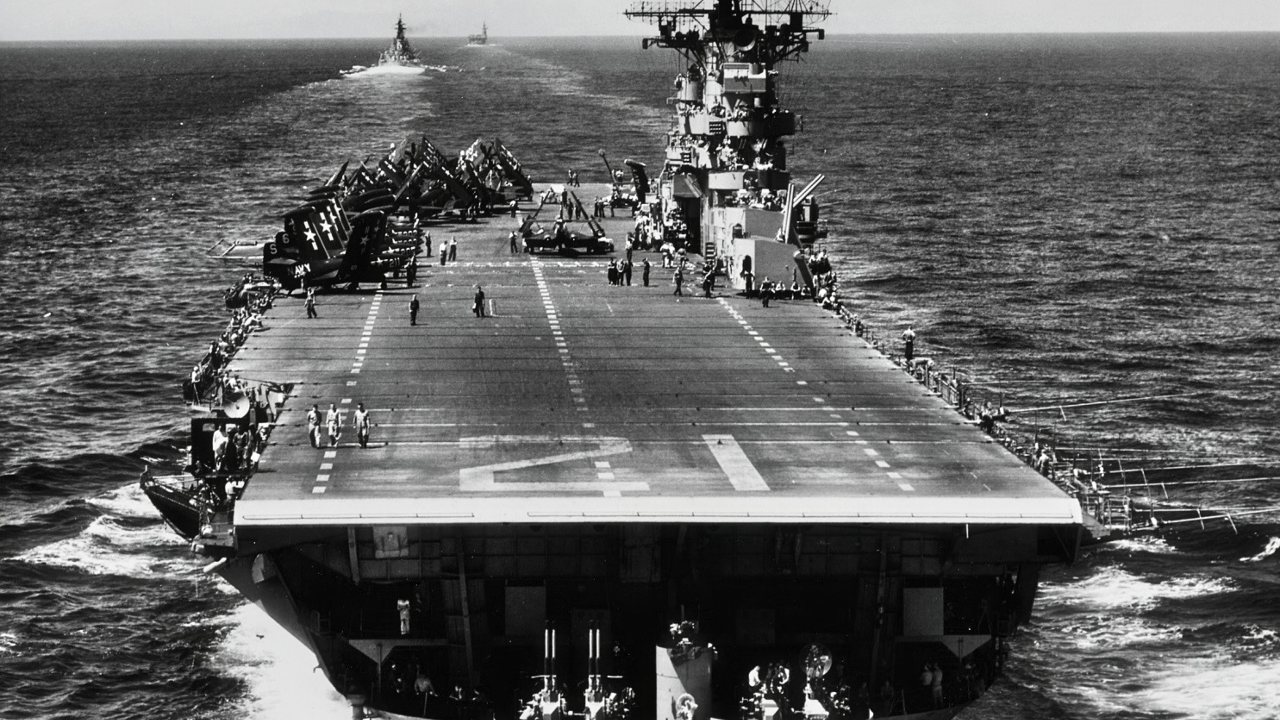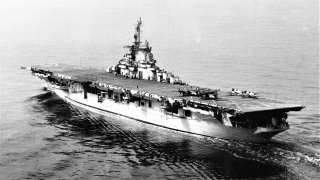U.S. Navy Essex-Class Aircraft Carrier USS Bennington Was a World War II Warrior
The USS Bennington, part of the U.S. Navy's Essex-class aircraft carriers, played a pivotal role during World War II and beyond. With a displacement of 34,000 tons and capable of speeds up to 17 miles per hour, the Bennington was a formidable presence, enhanced by innovative deck-edge elevators that increased flight deck area and operational efficiency.
Summary: The USS Bennington, part of the U.S. Navy's Essex-class aircraft carriers, played a pivotal role during World War II and beyond. With a displacement of 34,000 tons and capable of speeds up to 17 miles per hour, the Bennington was a formidable presence, enhanced by innovative deck-edge elevators that increased flight deck area and operational efficiency.
-Launched in 1944 from the New York Naval Shipyard, she joined Task Force 58 for actions in the Pacific, including the invasion of Okinawa.
-Post-war, the Bennington underwent modernization to accommodate jet aircraft and later served in the Vietnam War, providing anti-submarine support. Decommissioned in 1970, the USS Bennington was a significant asset in the U.S. naval fleet until being struck from the Naval Vessel Register in 1989.
The USS Bennington: A Storied Essex-Class Carrier from WWII to Vietnam
With its Essex class of aircraft carriers, the U.S. Navy fielded the largest capital ships of World War II. Constructed rapidly in the 1940s, the 24 ships in this class were significantly more capable than their predecessors. The Essex ships were freed from the Washington Naval Treaty’s tight restrictions, which limited displacement and armaments on earlier carriers. The class was later divided into the short-hull Essex class and the long-hull Ticonderoga sub-class.
The USS Bennington (CV/CVA/CVS-20) was one of these carriers. Constructed during the war, she served with distinction against Imperial Japan.
Introducing the USS Bennington
Like her sister ships, the Bennington could displace an average of 34,000 tons when fully loaded and sail at about 17 miles per hour.
These steam-powered warships were powered by four Westinghouse geared steam turbines and eight Babcock & Wilcox boilers. The Bennington and the rest of her class were equipped with a dozen 5 inch/38-caliber guns, Bofors 40 mm anti-aircraft (AA) guns and Oerlikon 20mm AA guns.
Perhaps the vessel’s most significant feature was the deck-edge elevator. By using a platform on the edge of the deck, instead of in the hangar, to move airframes up and down from the flight deck, naval engineers preserved space and weight while increasing the flight deck area.
Operational History
The USS Bennington was the second naval ship with a name honoring the 1777 battle near Bennington, Vermont, during the American Revolutionary War. She was laid down by the New York Naval Shipyard in 1942 and launched two years later.
Shortly after, the Bennington commissioned and immediately headed out to sea to complete shakedown training and other trials. After arriving at Pearl Harbor in 1945, the Bennington and other carriers attached to Task Force 58 sailed toward the Japanese home islands to prepare for the imminent invasion of Okinawa.

Following the operation, the Bennington remained in the Japanese home islands to support occupation forces. At the end of the decade, the warship set out to the U.S. East Coast and remained in reserve for almost four years. In 1950, the Bennington transferred to the New York Naval Shipyard to undergo a modernization overhaul. The ship’s displacement, length, and beam were increased, and her flight deck was widened to accommodate jet aircraft.
In the Vietnam War, the Bennington was assigned with the 7th Fleet. In her last assignment with the fleet, she provided anti-submarine protection and was responsible for tracking and locating all ships sailing in the vicinity of Task Force 77.
The Bennington was taken out of commission in 1970 and was placed with the Pacific Reserve Fleet at Puget Sound Naval Shipyard in Washington. She was officially stricken from the Naval Vessel Register in 1989.
About the Author: Maya Carlin
Maya Carlin, National Security Writer with The National Interest, is an analyst with the Center for Security Policy and a former Anna Sobol Levy Fellow at IDC Herzliya in Israel. She has by-lines in many publications, including The National Interest, Jerusalem Post, and Times of Israel. You can follow her on Twitter: @MayaCarlin.


